Edited (in order to be more precise): I have a csv file in which the label and value information is stored for each variable in dataframe A.
In the original dataframe A there are 250 variables. For demonstration purposes I have:
- Reduced dataframe A from 250 to 7 variables.
- Loaded the csv file with the information as a dataframe B and also reduced to 7 variables.
My specific question: How can I assign the information (e.g. label and value) in dataframe B per code to the variables in dataframe A. So far I can achieve my goal by doing this variable by variable.
I hope the question is now more specific. I have no idea whether I am completly wrong with my way of thinking. Would be grateful for any help.
my dataframe A:
structure(list(a = c(2L, 7L, 8L, 5L, 10L, 1L, 6L, 9L, 3L, 4L),
b = c("29.06.2016", "18.07.2016", "26.07.2016", "04.08.2016", "12.08.2016", "12.08.2016", "24.08.2016", "26.08.2016", "27.08.2016", "27.08.2016"),
c = c("A", "A", "B", "A", "C", "C", "B", "C","B", "C"),
d = c(4795L, 7242L, 2246L, 7914L, 9910L, 4279L,9174L, 8329L, 8310L, 4799L),
e = c(6L, 10L, 8L, 10L, 11L, 7L, 11L, 2L, 12L, 4L),
f = c(1973L, 1933L, 1977L, 1969L, 1960L, 1950L, 1963L, 1967L, 1951L, 1970L),
g = c(2L, 2L, 1L, 2L, 1L, 2L, 2L, 1L, 2L, 1L)), row.names = c(NA, -10L), class = "data.frame")
my dataframe B (info for labels and values):
structure(list(
variable = c("a", "b", "c", "d", "e", "f", "g"),
class = c("number", "string", "string", "string", "number", "number", "number"),
label = c("AAAA", "BBBB", "CCCC", "DDDD", "EEEE", "FFFF", "GGGG"),
values = c("",
"",
"",
"",
"@0@,@k.A.@,@1@,@Januar@,@2@,@Februar@,@3@,@März@,@4@,@April@,@5@,@Mai@,@6@,@Juni@,@7@,@Juli@,@8@,@August@,@9@,@September@,@10@,@Oktober@,@11@,@November@,@12@,@Dezember@",
"",
"@0@,@k.A.@,@1@,@female@,@2@,@male@")),
row.names = c(NA, -7L), class = "data.frame")
desired output:
